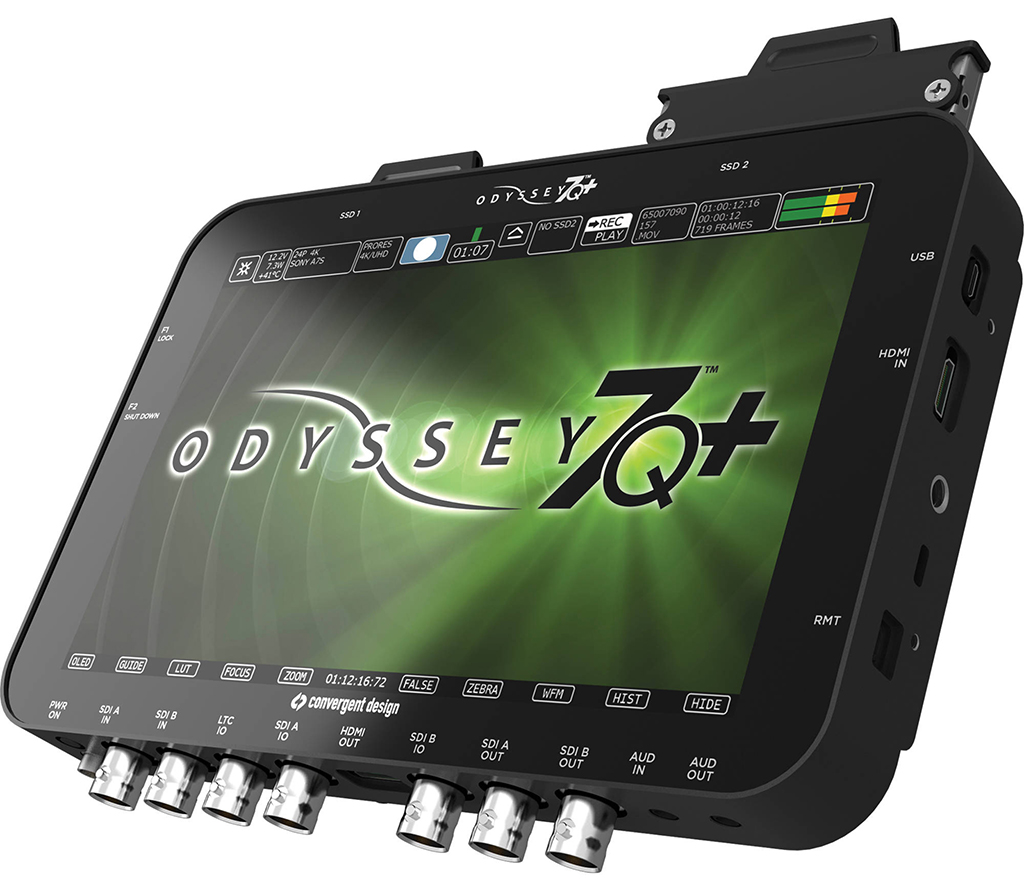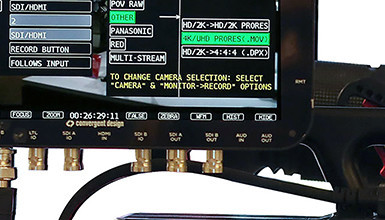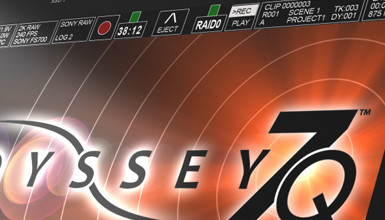
Let's start with LUTs. Up to 140 custom 3D-LUTs can be loaded into the Odyssey7Q or 7Q+. Cube sizes of 17x, 32x, 33x, 64x and 65x are supported in .cube format (.cube is the input format; a free app from Convergent is available to translate to the Odyssey's internal LUT format). At this point, LUTs are for viewing only, so it's not possible to "bake" the LUT into footage recorded by the Odyssey. However, any LUT used while footage is being recorded can be noted in an associated XML for re-application in post. Both extended and legal range LUTs are supported.
All of the image analysis tools (waveform monitor, histogram, etc.) can be set to measure the "LUTted" signal or the original source. This allows, for example, the scopes to reflect the exposure of a Log image while using a higher-contrast image via LUT for easier focusing, or for a viewing experience closer to the final grade for directors/producers. Each video output can be configured independently to display the LUTted signal or original source.
Another new monitoring feature is anamorphic de-squeeze at ratios of 1.33x, 1.5x and 2x. Similar to how LUTs are routed, the de-squeezed image is sent to the video outputs leaving the recorded image unaffected.
DCI 4K and 2K files feature a slightly different aspect ratio than HD and UHD (17:9 vs. 16:9). The Odyssey7Q and Q+ now allow either a letterboxed image within 16:9 or a center-cut of the 4K/2K image to 16:9. Again, the scaled or cropped image is available for monitoring but the unaltered image is always recorded.
Also new is the ability to monitor either just the luma signal or any of the individual R, B, G channels in monochrome. This is useful not only for projects being shot for presentation in black and white but also for evaluating channel balance.
Exposure tools have also received an update. There are now dual zebras that can each have a high and low setting, separately selectable colors, and can overlap. False color mode has also been expanded with the addition of pink, for six colors total. Each color can have a high and low value set and can overlap as well, like the zebras.
The monitor itself, an excellent OLED display, now features advanced calibration capabilities, with new controls for color channel bias and the ability to display SMPTE color bars for reference. Switching between inputs is now smoother as well, with no flickering or "glitching."
When powering down, the recorder now automatically does a safe eject on any mounted SSD storage blades, closing all file directories.
Among other image processing improvements is better color reproduction for Sony FS RAW, including improvements in CinemaDNG and Apple ProRes recording. For the FS700, there is Apple ProRes recording with S-Log2 or REC709 (800%). For the FS7, there's CinemaDNG and Apple ProRes, which requires SGamut3.Cine colorspace. The following bugs have been fixed in firmware v2015.5:
- AUD OUT (Headphones) unmute
- Audio gain settings when switching Analog to SDI
- Safe Eject process to remove OLED flashing during procedure
- FS700 4K RAW -> HD Apple ProRes detection
The following items have been improved in firmware v2015.5:
- 4K Apple ProRes playback
- 4K pixel zoom 1:1 and 2:1
- PSF output support in all modes
- Reduced overall power usage
- Interlaced playback support
- 4K -> HD Apple ProRes playback
Software Updates for firmware v2015.5:
- CD Apple ProRes Transfer Utility 1.7
- LUTs viewed during recording noted in XML file metadata
- Pomfort LiveGrade Support for Odyssey LUTs
To download v2015.5 (as well as updated manuals and 3D LUTs), visit visit Convergent Design's official firmware site: http://www.convergent-design.com/support/firmware-downloads.html

















